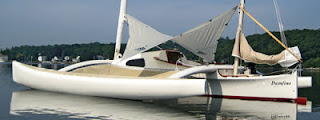Those who have followed trimaran designs and history will be familiar with the work of Dick Newick. One of his recent briefs was to create a 28' trimaran (Spark design) which is spiritually a multihull version of the famous Herreshoff Rozinante canoe yawl. The final boat (Damfino) is unmistakably Newick in design with gracious curved lines but is a sweet sailing boat with good handling and performance.
repost of article by Mike O'Brien
http://outyourbackdoor.com/OYB8/boats/boatspark.html
Spark...a Three Hulled Rosinante
By Mike
O'Brien
[Originally from Boat Design Quarterly #2 , but reprinted just
now from Messing About In Boats. Follow?]
Canoe yawls are small canoe
sterned cruisers. They are not canoes, they need not be yawl rigged, and Spark
demonstrates that they need not have only one hull. Dick Newick drew this light
trimaran for a client who wanted a threehulled version of Rozinante, a lovely
and deep rnonohull from L. Francis Herreshoff's table. The highly regarded
multihull designer understood that his new boat would have to be "elegantly
simple, handy, fast, and fun to sail".
To drive Spark's slender hulls,
Newick chose the rig devised by Dr. Ljungstrom in the 1930's after he lost his
son to a spinnaker accident. This system consists of a doubled, boomless,
battenless, legomutton mainsail that furls (and reefs after a fashion) around an
unstayed rotating mast. For beating and reaching, both layers of the sail lie
together and are sheeted to the same point, that is they act as a conventional
single sail. Off the wind, the sail can open like a butterfly's wings to double
the effective area.
Starting with a Ljungstromrigged 17' cruising kayak
in 1950, and proceeding through a 51' trimaran schooner (1988). Dick Newick must
have as much experience with doubled sails as any contemporary sailor.
The racing records of Newick's boats indicate that his performance
predictions ought not to be taken lightly. He forecasts that "Spark might not
beat a wingmasted trimaran to windward, but she should be ahead of almost
anything else. Flying a spinnakercloth, double duty jib/mizzen staysail, she
will do better than wind speed in any breeze under 8 knots. With working sail
you can expect 12 knots of boat speed in 15 knots of wind. She'll make 16 knots
easily when it's blowing 20. An 8hp outboard will push her to 7 knots, and a
yuloh ( a specially rigged, bent Asian sculling oar) will give 2
knots."
If Newick's Spark and Hereshoff's Rozinante share similar intent,
they also provide similar accommodations. Each has a solitary berth and an
extraordinarily comfortable cockpit. Neither boat has standing headroom, and
neither needs it. Most life functions can, or should, be performed while sitting
or reclining.
Nets fill the open spaces between Spark's hulls. Lying
prone on a speeding trimaran's net, suspended inches above the rushing stream of
warm water, must be one of life's great spiritual and physical pleasures,
dream-like free flight. The nets make fine beds on mild, bugless
nights.
Spark's hulls can be strip planked with cedar or lighter more
expensive DuraKore. In either case, they should be sheathed with fiberglass
cloth inside and out. Shaped and 'glassed foam forms the forward and after ends
of the amas (outer hulls). These "safety cushions" will disintegrate upon hard
impact.
Lofting this boat should be easy. Newick drew Spark's graceful
hull lines for publication here. He added a waterline and buttock lines to the
vaka drawings at my request. Later, he pointed out that these lines needn't be
shown for his boats because of their easy shape and selffairing lofting method.
From the many dictionary definitions for "spark'', Newick has chosen two
as fitting his boat: "A flash of light" and "to set in motion". As does
Rozinante, Spark possesses a spirit that transcends functional explanation. She
stirs a sailor's passion for efficient movement and
independence.
Contact: Richard C. Newick, 5 Shepherds Way, Kittery Point,
ME 03905.)



were any of these boats built? when? How was their performance?where are the boats now?
ReplyDelete